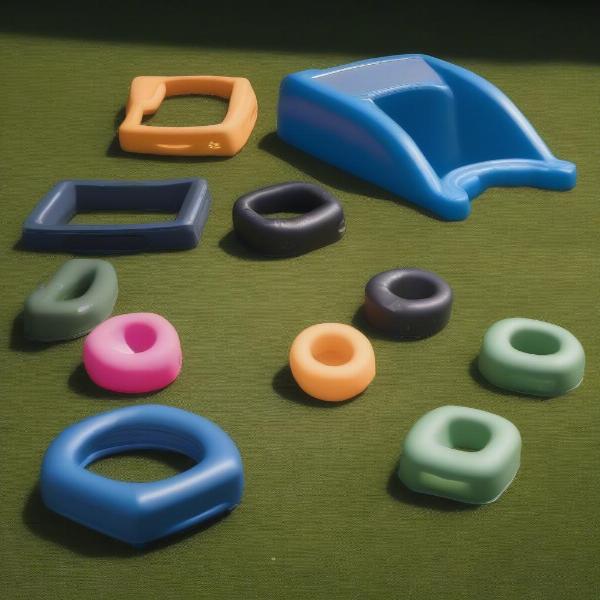Bumpers are essential tools for training gundogs and retrieving breeds, but they also offer a fantastic way to engage any dog in active play and obedience training. This guide will delve into the world of bumpers for dog training, covering everything from choosing the right bumper to incorporating them effectively into your training sessions.
Choosing the Right Bumper for Your Dog
 Chó tập luyện với bumpers
Chó tập luyện với bumpers
There’s a wide array of bumpers available, each designed with specific training goals in mind. Consider your dog’s size, age, and training level when making your selection. Puppies and smaller dogs benefit from softer, smaller bumpers, while larger, more experienced dogs can handle larger, more durable options. Material also plays a key role. Canvas bumpers are soft and ideal for introducing retrieving, while rubber bumpers are durable and suitable for water retrieves. Plastic bumpers, often scented, are great for advanced training.
Bumper Size and Material
The size of the bumper should be appropriate for your dog’s mouth size. Too small, and they might swallow it; too large, and they’ll struggle to carry it. Material-wise, consider the environment you’ll be training in. Canvas is great for land retrieves, while rubber or floating bumpers are essential for water work.
Incorporating Bumpers into Training
Start by introducing the bumper as a toy. Encourage your dog to interact with it, rewarding them with praise and treats when they show interest. Gradually introduce the “fetch” command, tossing the bumper a short distance and rewarding them when they retrieve it. As your dog progresses, increase the distance and introduce distractions to solidify their retrieving skills. Bumpers can also be used for scent work, obedience training, and even agility exercises.
Building a Strong Retrieve
A solid retrieve starts with a positive introduction to the bumper. Make it a fun game, using encouraging words and rewarding their efforts. Consistency is key, so practice regularly and keep the sessions short and engaging.
Advanced Bumper Training Techniques
Once your dog has mastered the basic retrieve, you can introduce more challenging exercises. Use multiple bumpers, hidden bumpers, or even scented bumpers to sharpen their skills. You can also incorporate bumpers into agility courses or use them for directional retrieves, where your dog learns to retrieve specific bumpers on command.
“Bumpers are invaluable for building a dog’s drive and focus, essential qualities for any working or sporting dog,” says renowned dog trainer, Sarah Miller. “But beyond their practical applications, bumpers provide a fantastic way to strengthen the bond between dog and owner through interactive play and training.”
Common Bumper Training Challenges and Solutions
- Dog Doesn’t Show Interest: Try a different material or scent. Sometimes, a simple change can spark their interest.
- Dog Drops the Bumper: Reinforce the “hold” command and reward them for holding the bumper.
- Dog Chews the Bumper: Choose a more durable bumper designed for chewing.
Conclusion
Bumpers are a versatile and effective tool for dog training, offering a range of benefits from basic retrieving to advanced scent work. By choosing the right bumper and incorporating it thoughtfully into your training sessions, you can enhance your dog’s skills, boost their confidence, and strengthen your bond.
FAQs
- What age can I start using bumpers with my puppy? You can introduce bumpers as early as a few months old, starting with soft, small bumpers appropriate for their size.
- Are bumpers only for hunting dogs? No, bumpers are a great training tool for any breed, promoting exercise, obedience, and mental stimulation.
- What are the best bumpers for water retrieves? Floating rubber bumpers are ideal for water retrieves, as they are durable and easy for your dog to spot.
- How do I clean a bumper? Most bumpers can be washed with soap and water. Check the manufacturer’s instructions for specific cleaning guidelines.
- Can I use bumpers for other activities besides retrieving? Yes, bumpers can be used for scent work, agility training, and even as a reward during obedience training.
- My dog is aggressive with the bumper. What should I do? Consult with a professional dog trainer to address the underlying aggression issues.
- What if my dog swallows a small piece of the bumper? Contact your veterinarian immediately if you suspect your dog has ingested any part of a bumper.
Related Articles on ILM Dog
ILM Dog is your trusted global resource for expert advice on dog care and training. We offer comprehensive guides on everything from breed selection and health care to nutrition and grooming. Whether you’re a seasoned dog owner or just starting your journey, ILM Dog provides the resources you need to nurture a happy, healthy canine companion. Contact us today for personalized guidance! Email: [email protected] Phone: +44 20-3965-8624.